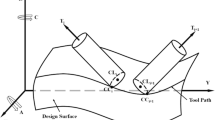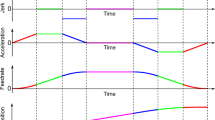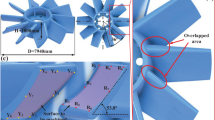Abstract
The 3 + 2 axis machining technology is of high feasibility and strong rigidity. Its feasible region determination is a prerequisite and indispensable. This paper focuses on feasible region determination without local interference for arbitrary revolving tools in 3 + 2 axis machining. A unified definition of revolving tools is firstly raised, and the normal vector surfaces are mapped to areas on a same unit sphere. The feasible region determination is transformed into a covering problem between two areas on a unit sphere, which are the normal vector surface of the tool and the negative normal vector surface of the machining area. This method is independent of tool geometry types. If the normal vector surfaces are determined, then the feasible region is obtained. To get more maneuverability, in the actual determination process, the negative normal vector surface of the machining area is approximated by a revolving surface on a unit sphere which is called as its γ-revolving surface in this paper, and the error is analyzed. The γ-revolving surface is obtained by the steepest descent method to search the minimum revolving surface in a certain sense. The covering problem between two revolving surfaces on a unit sphere is solved on a plane, which equals to consider the covering between their generatrices. In the validation, the feasibility of tool axes in feasible regions’ different positions is verified, and the method is used in tool selection.
Similar content being viewed by others
References
Lasemi A, Xue D, Gu P (2010) Recent development in CNC machining of freeform surfaces: a state-of-the-art review. Comput Aided Des 42(7):641–654
Gray P, Bedi S, Ismail F, Rao N, Morphy G (2001) Comparison of 5-axis and 3-axis finish machining of hydroforming die inserts. Int J Adv Manuf Technol 17(8):562–569
Suh SH, Lee JJ, Kim SK (1998) Multiaxis machining with additional-axis NC system: theory and development. Int J Adv Manuf Technol 14(12):865–875
Suh S, Lee J (1998) Five-axis part machining with three-axis CNC machine and indexing table. ASME J Manuf Sci Eng 120:120–128
Chen Z, Dong Z, Vickers GW (2003) Automated surface subdivision and tool path generation for 3 1/2 1/2-axis CNC machining of sculptured parts. Comput Ind 50(3):319–331
Roman A, Bedi S, Ismail F (2006) Three-half and half-axis patch-by-patch NC machining of sculptured surfaces. Int J Adv Manuf Technol 29(5):524–531
Flores AR (2007) Surface partitioning for 3+2-axis machining [dissertation]. Waterloo, ON, Canada: University of Waterloo
Gray PJ, Ismail F, Bedi S (2007) Arc-intersect method for 3 1/ 2 1/ 2 -axis tool paths on a 5-axis machine. Int J Mach Tools Manuf 47(1):182–190
Bi Q, Ding H, Wang Y (2008) Safe and short tool length generation for 3+2 axis NC machining of a ball-end cutter using graphics hardware[conference]. ICIRA 2008: Proceedings of the first international conference on intelligent robotics and applications, Oct 15–17, Wuhan, China
Zhu Y, Chen Z, Ning T, Xu R (2016) Tool orientation optimization for 3 + 2-axis CNC machining of sculptured surface. Comput Aided Des 77:60–72
Lee YS (1997) Admissible tool orientation control of gouging avoidance for 5-axis complex surface machining. Comput Aided Des 29(7):507–521
Rao A, Sarma R (2000) On local gouging in five-axis sculptured surface machining using flat-end tools. Comput Aided Des 32:409–420
Chen T, Ye PQ, Wang JS (2005) Local interference detection and avoidance in five-axis NC machining of sculptured surfaces. Int J Adv Manuf Technol 25:343–349
Lee S, Lee N (2002) New method of tool orientation determination by enveloping element for five-axis machining of spatial cam. Int J Prod Res 40(10):2379–2398
Xu X, Bradley C, Zhang Y, Loh H, Wong Y (2002) Tool-path generation for five-axis machining of free-form surfaces based on accessibility analysis. Int J Prod Res 40(14):3253–3327
Javad M, Fard B, Feng H (2011) New criteria for tool orientation determination in five-axis sculptured surface machining. Int J Prod Res 49(20):5999–6015
He Y, Chen ZT, Xu RF, Wu XZ (2015) Reducing fluctuation of machining strip width by tool position modification for five-axis NC machining of sculptured surfaces. Int J Adv Manuf Technol 78:249–257
Jun C, Cha K, Lee Y (2003) Optimizing tool orientations for 5-axis machining by configuration-space search method. Comput Aided Des 35:549–566
Mi Z, Yuan C, Ma X (2017) Tool orientation optimization for 5-axis machining with C-space method. Int J Adv Manuf Technol 88:1243–1255
Zhu W, Lee Y (2004) Five-axis pencil-cut planning and virtual prototyping with 5-DOF haptic interface. Comput Aided Des 34:1295–1307
Bi Q, Wang Y, Ding H (2010) GPU based algorithm for generating collision free and orientation smooth five axis finishing tool paths of a ball end cutter. Int J Prod Res 48(4):1105–1124
Li S, Tang M, Luo M (2011) Optimal tool orientation planning for five-axis machining of open blisk[conference]. International Conference on Intelligent Computation Technology and Automation 1138–1141
Tang M, Zhang D, Luo M, Wu B (2012) Tool path generation for clean-up machining of impeller by point-searching based method. Chin J Aeronaut 25:131–136
Zhao J, Zhong B, Zou Q, Liu H (2013) Tool orientation planning for five-axis CNC machining of open free-form surfaces. J Syst Sci Complex 26:667–675
Si W, Ning T, Chen Z (2014) Tool position feasible area of torus tool in machining blade root transitional surfaces. Acta Aeronaut Astronaut Sin 35:1–9
Kim Y, Elber G, Michael B, Helmut P (2015) Precise gouging-free tool orientations for 5-axis CNC machining. Comput Aided Des 58:220–229
Wang Q, Feng Y, Zhang Z, Tan J (2017) Tool orientation sequence smoothing method based on the discrete domain of feasible orientations. Int J Adv Manuf Technol 92:4501–4510
Gan ZW (2016) Envelope motions of CNC cutters in wide strip machining [dissertation].Beijing, China: Beihang university
Yuan YX (1997) Optimization theory and methods [monograph]. Beijing China: The Science Publishing Company. 1th Edition: 5–7
Rong SL, Koren Y (1996) Efficient tool-path planning for machining freeform surfaces. J Eng Ind 118:20–28
Vickers GW, Quan KW (1989) Ball-mills versus end-mills for curved surface machining. J Eng Ind 111(22):22–26
Denkena B, Boess V, Nespor D (2015) Engine blade regeneration: a literature review on common technologies in terms of machining. Int J Adv Manuf Technol 81(5–8):917–924
Chen X, Xu Z, Zhu D (2016) Experimental research on electrochemical machining of titanium alloy Ti60 for a blisk. Chin J Aeronaut 29(1):274–282
Fu Y, Gao H, Wang X (2017) Machining the integral impeller and blisk of aero-engines: a review of surface finishing and strengthening technologies. Chin J Mech Eng 30(3):528–543
Chaves-Jacob J, Poulachon G, Duc E (2012) Optimal strategy for finishing impeller blade using 5-axis machining. Int J Adv Manuf Technol 58(5–8):573–583
Rao N, Bedi S, Buchal R (1996) Implementation of the principal-axis method for machining of complex surfaces. Int J Adv Manuf Technol 11(4):249–257
Acknowledgments
The reported work was supported by the Chinese National Science and Technology Major Project 2015ZX04001201. Moreover, we thank the anonymous reviewers for their constructive comments.
Author information
Authors and Affiliations
Corresponding author
Rights and permissions
About this article
Cite this article
Shanshan, L., Zhiwang, G., Zhitong, C. et al. Feasible region determination without local interference of 3 + 2 axis machining for arbitrary revolving tools. Int J Adv Manuf Technol 102, 1985–2000 (2019). https://doi.org/10.1007/s00170-018-03224-6
Received:
Accepted:
Published:
Issue Date:
DOI: https://doi.org/10.1007/s00170-018-03224-6




